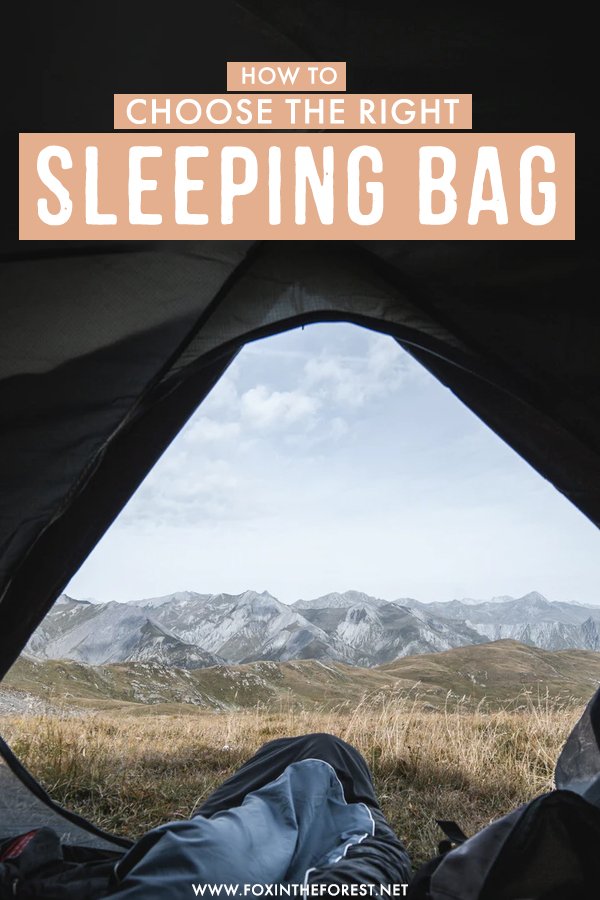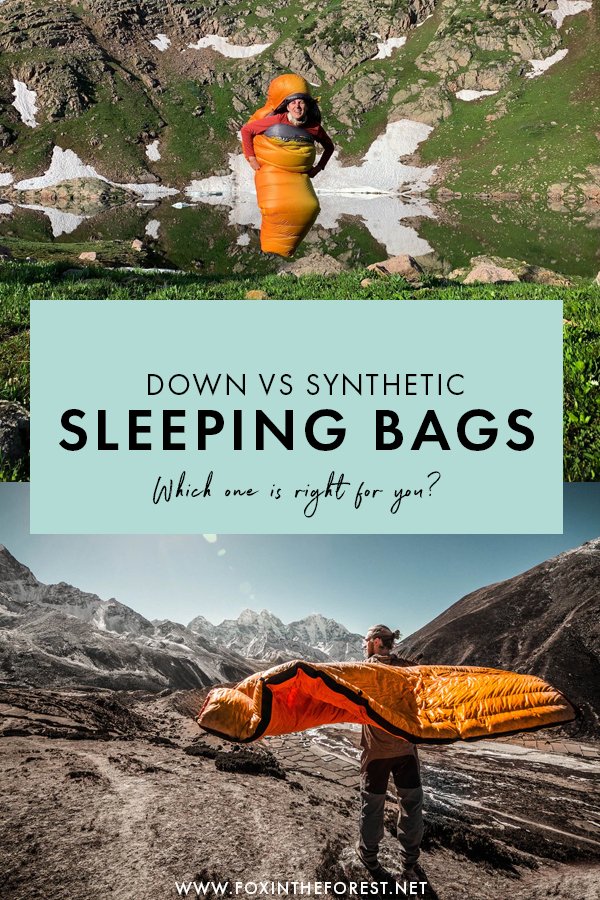Last Updated on November 5, 2021 by foxintheforest
So you’re in the market for a new sleeping bag. That’s awesome! You’ve come to the right place. In this guide to selecting a down vs synthetic sleeping bag, we’ll dive into all the nitty-gritty details of what to look for when you buy a sleeping bag.
As many of you may know, part of my full-time job is to review camping and backpacking gear. As an outdoor industry professional, I’ve got the inside scoop on all things sleeping bags!
A sleeping bag is a big buy – especially if you’re looking for something to suit all of your needs. I’m breaking down the differences between a down vs sythnetic sleeping bag so you can make the buying decision that’s right for your adventures.
About this Guide to a Down Vs Synthetic Sleeping Bag
When it comes to outdoor gear, sleeping bags are surprisingly complicated. There’s so much to consider that it can quickly get overwhelming. Don’t worry, with a few handy tips you’ll be able to buy the right sleeping bag for your night under the stars. Here’s what this guide will cover:
- How to choose a sleeping bag
- The differences between a down vs synthetic sleeping bag
- Quick tips for buying a sleeping bag
- Understanding temperature ratings of sleeping bags
- Additional features to keep in mind when you buy a sleeping bag
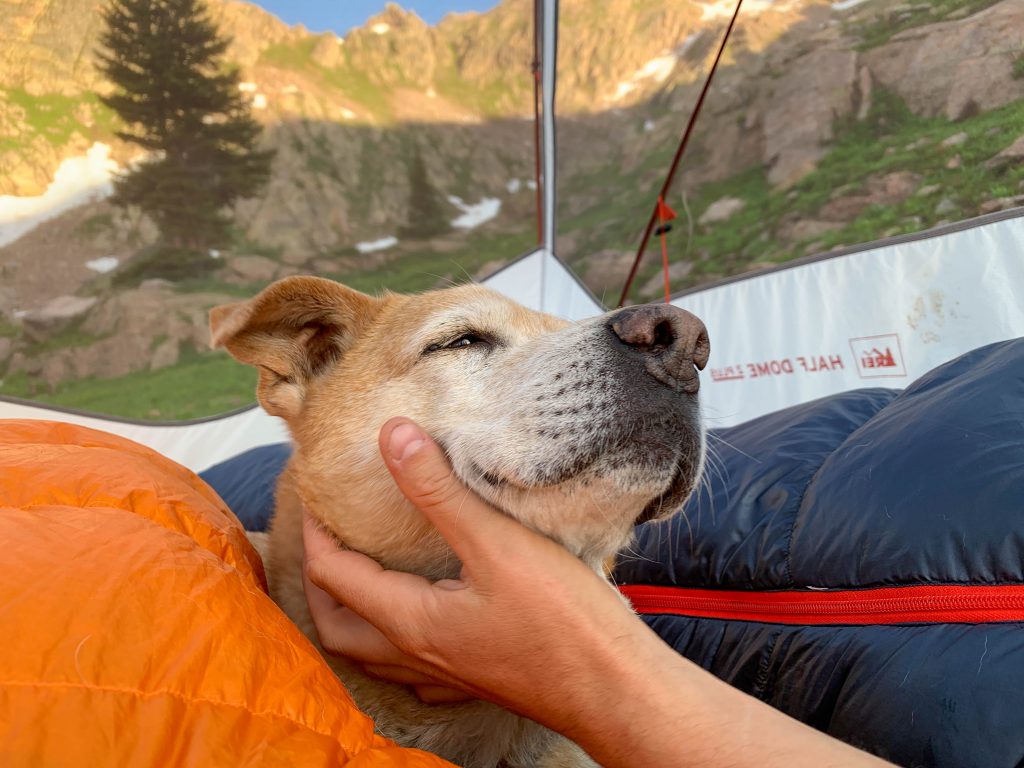
How to Choose a Sleeping Bag
Before you can even care about the differences between a synthetic vs down sleeping bag, you’ll want to know what type of bag will best suit your needs.
Before you buy a sleeping bag, answer the following questions:
- What activities do you enjoy? If you backpack, you’ll want something light and compact. If you primarily car camp, you can opt for an array of bags and forget about paying for something lightweight.
- Do you sleep cold or hot? Cold sleepers want a bag with more insulation value and a lower comfort rating. Typically this is a down sleeping bag.
- What sleeping pad do you use? This helps you decide how much warmth you need. If you’ve got a warm pad and you sleep on the warmer side, you can get away with a cooler bag.
- What season’s do you camp in? If you’re a fair-weather camper, then you’ll want a 2 or 3 season bag. Winter campers will always want a 4 season, down sleeping bag.
- What type of sleeper are you? If you need a lot of room (sleep curled up), you’ll need a specifically shaped sleeping bag. If you’re a side or back sleeper, a traditional mummy style will serve you well.
- What is your budget? Down is expensive and so is lightweight camping gear. Your budget will help you decide what you can spend. However, don’t forget there are many ways to score a deal on sleeping bags.
Down Vs Synthetic Sleeping Bags
There are two types of fill, or the fluffy stuff, that goes into a sleeping bag: down (typically insulative duck or goose feathers) or synthetic. The materials each have their benefits and drawbacks.
Down material is the lightest choice for sleeping bags. It’s also the warmers per ounce, but down bags are more expensive.
However, down doesn’t do a great job when wet and requires special care. You’ll want a sleeping bag that has hydrophobic down and a water-rappelling shell so your sleeping bag stays warm even if it gets damp.
Sustainable Tip: Search for sustainably sourced down sleeping bags. The Responsible Down Standard (RDS) or the Traceable Down Standard (TDS) ensures that down is ethically and sustainably sourced, not causing harm to the animals.
Related: Incredible Eco-Friendly Outdoor Gear that Gives Back
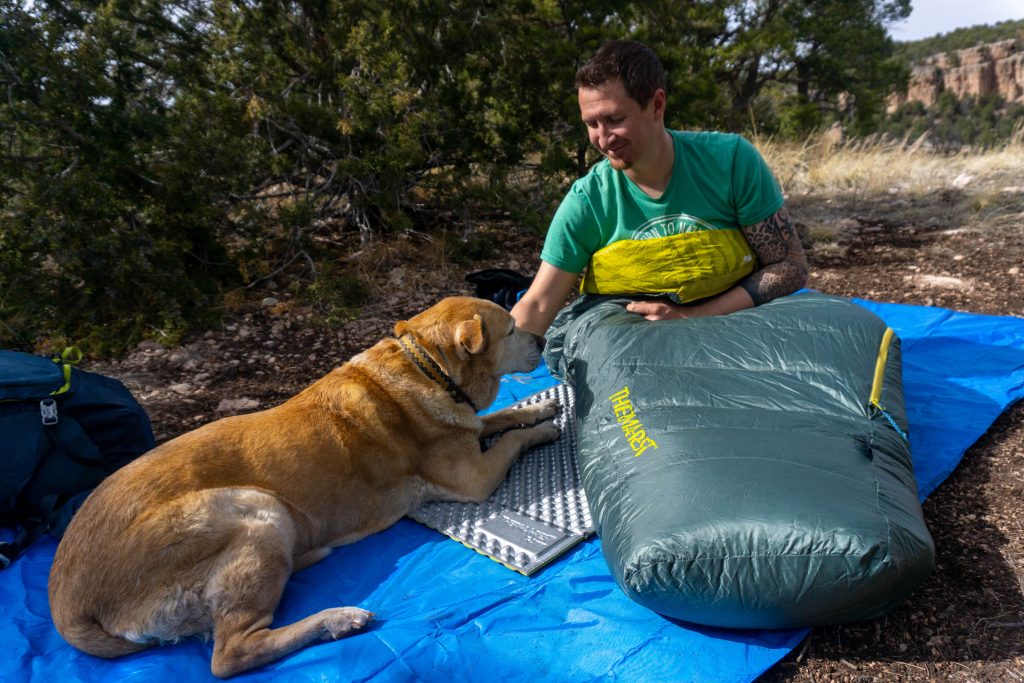
Synthetic sleeping bags are far more budget-friendly. They use extruded plastics to create a warm fill. Typically, these fills are far heavier per ounce than their down counterparts, but they still keep you warm if they get wet.
Also, synthetic sleeping bags break down easier, meaning the loft, or fluff breaks down quickly and doesn’t bounce back as easily as down. Also, the sustainable implications of using what is essentially single-use plastic to fill your sleeping bag is something for those who are eco-conscious to consider.
Down Sleeping Bags Are Best for…
You may be asking, what sleeping bag is right for me? Comparing a down vs a synthetic sleeping bag might seem confusing, especially if you’re on a limited budget.
Of course you wnat the best sleeping bag your money can buy. Down sleeping bags are ideal for…
- Avid backpackers. These bags are lightweight and more compressible, making them the ideal choice for carrying long distances. A down sleeping bag should be at the heart of a backpacker’s gear list.
- Thru-hikers. See above.
- Cold sleepers. If you sleep cold and your old synthetic bag just isn’t cutting it, upgrade to a down bag.
- Winter campers. You simply must have a down bag if you want to camp in freezing temps.
- You have a bigger budget. These bags typically cost 20-30% more than synthetic bags.
- You’re eco-conscious. Yes, this is a luxury, but these bags are far more biodegradable, sustainable, and have a longer life span than their synthetic counterparts.
Synthetic Sleeping Bags are Best for…
If you’re comparing a down v a synthetic sleeping bag, you want to understand the benefits of a synthetic bag. Choose a synthetic sleeping bag that fits your needs if…
- You are on a limited budget. These bags offer the best bang for your buck.
- You car camp more often than you backpack. Synthetic bags are heavier and if you’re just tent camping or car camping,
- You’ve got a larger backpacking pack. Listen, I get it. Not everyone has $300 to throw at a sleeping bag to go backpacking. I used a synthetic sleeping bag for backpacking for nearly 3 years before I bought a down bag. If you have a larger (think 55L an up) backpacking bag, you can get away with a synthetic bag if you don’t mind the weight.
- You’re buying for kids. Kids will quickly grow out of things, so why over-spend. Get a synthetic bag to save some mullah.
- You sleep hot. A down bag might feel a bit stifling if you’re a warm sleeper. Get a synthetic bag to stay cozy instead.
- You’re allergic to down. Synthetic bags are hypoallergenic.
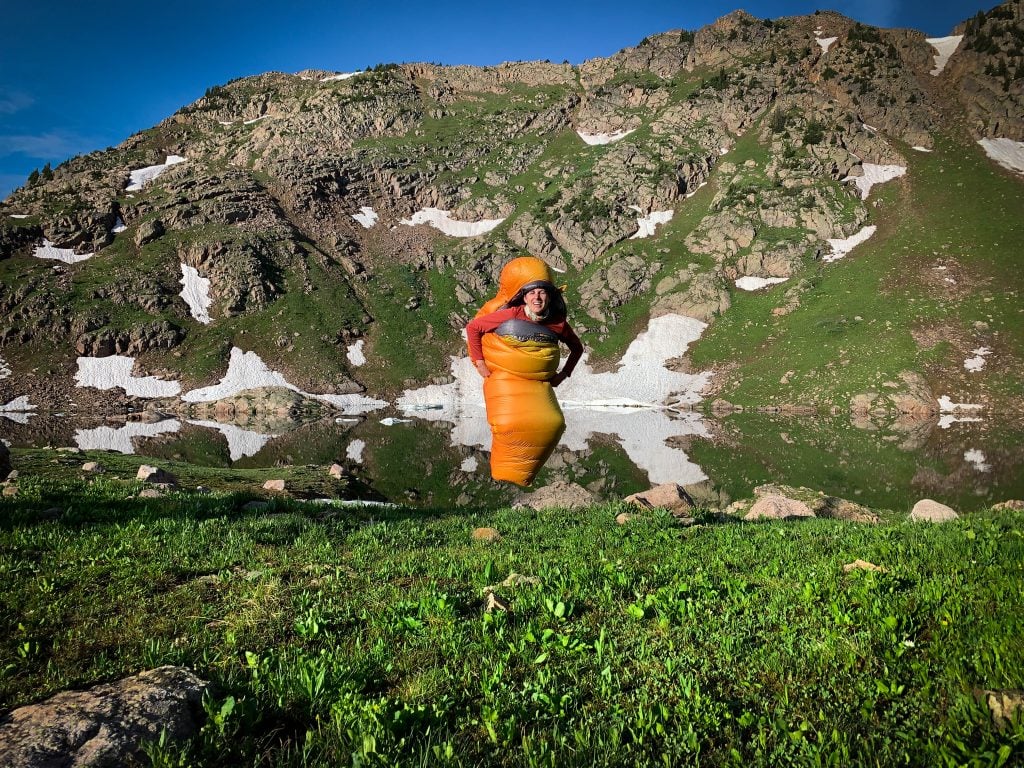
Temperature Ratings in Sleeping Bags
Now that you’ve decided whether to buy a down or synthetic sleeping bag, you’ll want to decide which sleeping bag is right for you.
To save you all of the science and controversy, most sleeping bag manufacturers have adopted the EN (European Norm) standard for temperature ratings.
These ratings evolved from looking at the temperature a normal person sleeps. As it turns out, women sleep colder than men, so you’ll find some differences between the male/unisex bags and women’s specific sleeping bags.
You’ll find two numbers. The first is the Comfort Rating. This number represents what temperature the average woman will find comfortable and the lower limit is for the average temperature a man will remain comfortable.
The lower limit number also indicates the lowest limit at which you can sleep safely. It’s not really a number you want to find yourself testing out, so try to select a sleeping bag that has a lower temperature rating than what you’ll typically be sleeping in. Here’s a breakdown:
- Summer: 30 degrees and higher for your lower limit.
- 3 season: 15 to 30 degrees for the lower limit.
- Winter: 15 degrees and lower for the lower limit.
Additional Sleeping Bag Features
Of course, there are other sleeping bag features you’ll want to consider than just comparing a down v synthetic sleeping bag. Here’s a look at other things to consider:
- Shape. What kind of sleeper are you? Do you need more room and don’t mind the weight or the warmth factor? Remember roomier bags take longer to heat.
- Pockets. Do you need any pockets for your phone, lip balm or other accessories?
- Compression. Does the bag compress well?
- Zipper features. What side does it zip? Can you zip it together with your partners if you want? Is there a protective element to the zipper that makes snags less likely? Is there a baffle (insulated fabric strip) covering the zipper to stop heat from seeping out?
- Hood. Do you need a hood to sleep warmer?
Now you’ve got the inside scoop on down vs synthetic sleeping bags. With the right know-how, you can buy the best sleeping bag for your next big adventure.
More Backpacking and Camping Gear Resources
Looking to get into backpacking and camping? I’ve dedicated my blog to giving you exclusive, insider tips on outdoor gear, adventures, and more:
- Camping 101: What You Need to Know
- Tips for Camping in the Desert
- Fantastic Car Camping Gear You Can’t Live Without
- Things to Know for Your First Backpacking Adventure
- The Only Guide to Hiking Gear for Women that You’ll Ever Need
